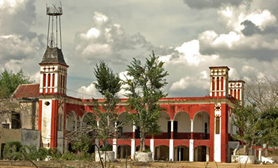Campeche Museums, Historic Buildings & Haciendas
Campeche’s historic buildings are protected by decree to keep them from being destroyed or altered by the growth of the city. Campeche is one of the least known and unrated colonial cities in Mexico, mostly bypassed by those visiting more famous destinations in the Yucatan peninsula. Campeche was one of the most important ports in New Spain.
Campeche has a number of colonial era churches like the Asunción church in Dzitbalché was constructed in the 18th century, with a pointed arch doorway, choral window and bell-gable. The Guadalupe Church in Bécal, Calkiní was built in the 18th century. The San Diego Apóstol Church in Nunkiní, Calkiní was built in the late 16th and early 17th centuries. The Cathedral of Campeche is from the 16th century. Its façade is of worked stone with two levels marked off by two grooved pilasters. The San Francisco Church in Campeche was established in the 16th century although the current building dates from the 17th. The church and former monastery of San Luis Obispo is located in Calkiní, built in the 17th century of stone, wood and metal over a former Mayan temple. The facade is simple with a bell-gable and there remains only one of its original Baroque altarpieces, which was made in the 16th century. The church marks the spot where the first mass was held on mainland America. Most of the state’s colonial era churches are located in and near the city of Campeche, with some in Ciudad del Carmen. The Sagrado Corazón de Jesús Church was built in the 18th century in Sabancuy, Carmen. The church and former monastery of San Francisco de Asís was begun in the 16th century by the Franciscans in Hecelchakán. The Nuestra Señora del Carmen Church in Ciudad del Carmen was built in the 18th century.
Outside of the city of Campeche, much of the notable civil architecture in the state is found on the various former haciendas. Many of these haciendas have been turned into hotels, spas and other tourist attractions. Hacienda Blanca Flor is located in Hecelchakán outside Campeche. This hacienda was a site of one of the bloodiest battles of the Caste War. Hacienda Santa Cruz is between Campeche and Calkiní in the Nunkiní community. It is dated to the middle of the 18th century established to raise cattle. It continued operating until the Mexican Revolution. Hacienda San José Carpizo is in the Champotón municipality, founded in 1871 by José María Carpizo Sánchez and was one of the most important on the Yucatán Peninsula, raising cattle. It survived the Mexican Revolution until its workers abandoned it in the 1940s. Hacienda San Luis Carpizo is located in Champotón and belonged to José María Carpizo, dedicated to agriculture. This hacienda was restored by the Mexican Army to house the Marine Infantry School in 1999. Hacienda Uayamón is near the city of Campeche with origins in the 16th century. It was attacked and its owner killed in the raid by Laurens de Graaf in 1685. It continued to operate until the Mexican Revolution and today it is home to the Hotel de Gran Turismo. Hacienda Tankuché was dedicated to raising dyewood (palo de tinte) but changed later to henequen. Despite losing most of its land in the Revolution, its henequen mill continued to operate until the 1980s.
Notable museums in the state include the Del Carmen Archeological Museum, the Museo de las Estelas Mayas in Ciudad del Carmen and the Camino Real Archeological Museum in Hecelchakán. The Museo Fuerte de San Miguel is located on one of the Campeche’s old forts. The museum is dedicated to the state’s history. Opened in 2000, it is the newest and most modern of Campeche’s museums.




